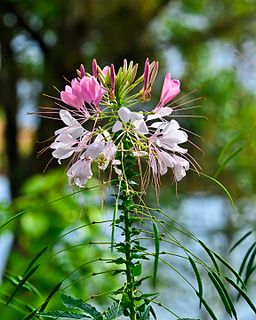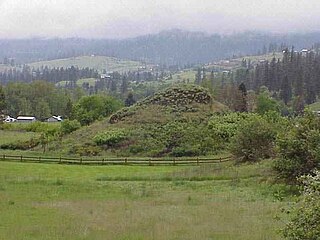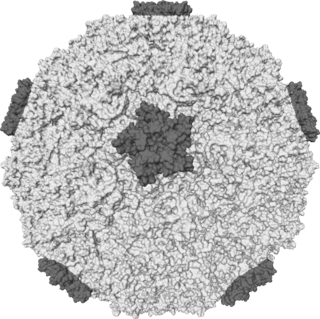
Platystemon is a monotypic genus of flowering plants in the poppy family containing the single species Platystemon californicus, which is known by the common name creamcups. It is native to Oregon, California, Arizona, Utah and Baja California, and is found in open grasslands and sandy soils below 6,000 feet (1,800 m) elevation.
Cleome sparsifolia is a species of cleome known by the common names fewleaf cleome and fewleaf spiderflower. This annual wildflower is native to California and Nevada where it grows in desert sand. This is an erect, branching plant not exceeding a meter in height. Its sparse leaves are each made up of 3 thick, oval-shaped leaflets. The bright yellow flowers have curving petals and long stamens tipped with knobby anthers. The fruit is a capsule up to 4 centimeters long.

Helianthemum greenei is a rare species of flowering plant in the rock-rose family known by the common name island rush-rose. It is endemic to the Channel Islands of California, where it grows in the chaparral of the rocky seaside slopes. It is present on three of the eight islands, where it has historically been threatened by feral herbivores such as the Santa Cruz sheep and is making a gradual recovery. It is a federally listed threatened species.
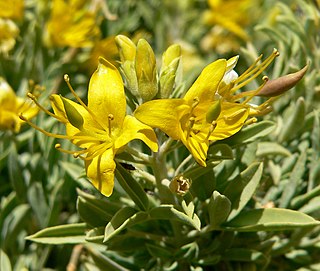
Peritoma arborea, is a perennial shrub or bush in the spiderflower family (Cleomaceae) known by the common names bladderpod, bladderpod spiderflower and burro-fat. It has yellow flowers in bloom all months of the year. It emits a foul odor to discourage herbivory from insects.
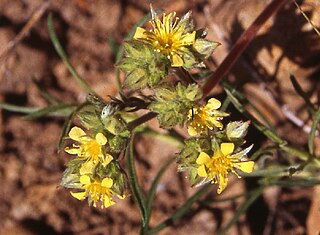
Ivesia aperta is a species of flowering plant in the rose family known by the common name Sierra Valley mousetail.

Lepidium flavum is a species of flowering plant in the mustard family known by the common name yellow pepperweed. It is native to California, Nevada, and Baja California, where it grows in the Sonoran and Mojave Deserts. The species epithet flavum is Latin for yellow and indicates its flower colour.

Lepidium perfoliatum is a species of flowering plant in the mustard family known by the common names clasping pepperweed and perfoliate pepperwort. It is native to Europe and Asia and it can be found in other parts of the world as an introduced species.

Camissoniopsis bistorta is a species of flowering plant in the evening primrose family known by the common names southern suncup and California suncup. It is native to southern California and Baja California, where it grows in several types of plant community along the coast and in the coastal hills and mountain ranges. This is a hairy annual or perennial herb spreading from a basal rosette with stems reaching up to 80 centimeters long. Leaves are lance-shaped to narrowly arrowhead-shaped and sometimes toothed, and 1 to 12 centimeters in length. Toward the end of the spreading stems are nodding inflorescences of flowers, each flower with four bright yellow petals dotted with red at their bases. At the center are stamens and a protruding, nearly spherical stigma. The fruit is a straight or slightly coiled capsule up to 4 centimeters long.

Ammannia coccinea is a species of flowering plant in the loosestrife family known by several common names, including valley redstem, scarlet toothcup, and purple ammannia. It is native to most of the contiguous United States, with the exception of the Pacific Northwest and New England. It is generally found in moist areas, such as riverbanks and pond margins. It is weedy in some areas. This is an annual herb growing erect to heights approaching one meter or lying along the ground. Leaves are linear in shape, up to 8 centimeters long, and green to shades of deep red in color. The inflorescence is a cluster of 3 to 5 flowers growing in the leaf axils along the upper part of the stem. The rounded flower has small rose to lavender petals each a few millimeters long and protruding stamens with yellow anthers. The fruit is a rounded capsule up to half a centimeter wide containing many tiny seeds.

Calochortus obispoensis is a rare California species of flowering plants in the lily family known by the common name San Luis mariposa lily. It is endemic to San Luis Obispo County, California, where it grows in the chaparral of the coastal mountains, generally on serpentine soils.

Neoholmgrenia andina is a species of evening primrose known by the common name Blackfoot River evening primrose. It is native to western North America, including southern Canada and much of the western United States, where it is a plant of mountains, and sagebrush plateaus. It is a small annual herb growing a hairy, branching stem generally under 15 centimeters tall. The bunched leaves are widely lance-shaped and 1 to 3 centimeters long. The inflorescence bears one or more flowers with usually four tiny bright yellow petals. The fruit is a flat capsule up to a centimeter long.
Tetrapteron graciliflorum is a species of evening primrose known by the common name hill suncup. It is native to Oregon and California, where it grows in several habitat types, often on clay soils. It is an annual herb generally with no stem but producing an upright, nodding inflorescence. There is a cluster of narrow leaves each one to ten centimeters long. The flowers have bright yellow petals one half to two centimeters long. The fruit is a leathery capsule less than a centimeter in length with four chambers containing bumpy brown seeds.

Cleome platycarpa is a species of flowering plant in the cleome family known by the common names golden bee plant and golden spiderflower. It is native to the western United States from northeastern California to Idaho, including the Modoc Plateau, where it grows on clay and volcanic soils in the sagebrush. It is an annual herb branching at the base into several erect stems up to about 60 centimeters tall. The stems are green tinted with purple, coated densely in glandular hairs, and lined with many leaves. Each leaf is divided into three small leaflets. The top of each stem is occupied by a raceme of many flowers. Each flower has generally four yellow sepals and four yellow petals around a center of many yellow stamens. The fruit is a flat, hairy capsule up to 2.5 centimeters long which hangs on the long, remaining flower receptacle.
Cleomella brevipes is a species of flowering plant in the cleome family known by the common name shortstalk stinkweed. It is native to the Mojave Desert and adjacent hills, where it grows in wet alkaline environments such as mineral-rich desert hot springs. It is an annual herb producing a rough, waxy, red stem up to about 45 centimeters tall. The stem is lined with many small fleshy leaves, each divided into three leaflets. Flowers appear in the leaf axils all along the stem, often all the way down to the base. Each grows at the end of a short, erect pedicel. The flower has four tiny yellow sepals and four tiny yellow petals. The fruit is a somewhat rounded, hanging capsule developing at the end of the remaining flower receptacle.
Cleomella obtusifolia is a species of flowering plant in the cleome family known by the common name Mojave stinkweed. It is native to the Mojave Desert and adjacent hills, where it grows in alkaline soils in the desert scrub. It is an annual herb producing a rough, hairy stem up to 90 centimeters long. The branching stem grows erect when new and then the branches droop to the ground with age, forming a bushy clump or mat. Each leaf is made up of three fleshy oval leaflets. Flowers appear in dense racemes on older stems and solitary in leaf axils on new stems. Each flower has generally four hairy green sepals and four yellow petals grouped together on one side of the involucre. The whiskery yellow stamens protrude up to 1.5 centimeters from the flower. The fruit is a hairy, valved capsule a few millimeters in length. It hangs at the tip of the remaining flower receptacle.
Cleomella parviflora is a species of flowering plant in the cleome family known by the common name slender stinkweed. It is native to eastern California and western Nevada, where it grows in desert and sagebrush scrub in the Mojave Desert and southern parts of the Great Basin. It is an annual herb producing a smooth, hairless, reddish stem up to about 45 centimeters tall. There are a few leaves, each made up of three elongated, fleshy leaflets. Most of the flowers are located in a raceme at the tips of the stem branches, and there may be a few solitary flowers in the axils of the leaves. Each flower has four tiny pale yellow petals, each about 2 millimeters long. The fruit is a lobed, valved capsule which hangs on the tip of the remaining flower receptacle.

Cleomella plocasperma is a species of flowering plant in the cleome family known by the common name twisted cleomella and alkali stinkweed. It is native to the Great Basin and Mojave Desert in the western United States, where it grows mainly in wet, alkaline soils such as those around hot springs. There is a disjunct population in the Bruneau Valley of southwestern Idaho. It grows with other halophytic species such as saltgrass and greasewood. This is an annual herb producing a smooth, hairless stem which divides into several erect or upright branches which may exceed half a meter tall. The sparse leaves are each split into three narrow leaflets. The flowers occur in a raceme at the top of each stem branch. Each flower has four yellow petals and several long stamens which may be over a centimeter long. The fruit is a capsule with large lobes. It hangs at the tip of the remaining flower receptacle.

Oxystylis is a monotypic genus of flowering plants currently considered a part of the cleome family containing the single species Oxystylis lutea, which is known by the common name spiny caper. It is native to the Mojave Desert straddling the border between California and Nevada. It grows in rocky and sandy desert habitat, often on alkaline soils. This is an annual herb producing an erect, branching stem which may reach 1.5 meters in height. The leaf is made up of three thick, firm leaflets 2 to 6 centimeters long, borne on a stout, straight petiole. The inflorescence is a dense head of flowers clustered about the stem at the leaf axils, each flower with four small yellow petals. The fruit is a small white or purple nutlet bearing the spine-like remnant of the flower receptacle.
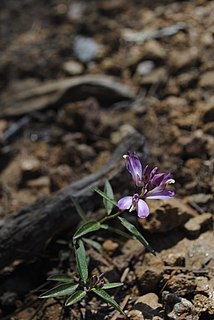
Polygala californica is a species of flowering plant in the milkwort family known by the common name California milkwort. It is native to southwestern Oregon and northern and central California, where it grows in the coastal mountain ranges in local habitat types such as chaparral and forest. It is a perennial herb producing spreading stems, generally decumbent in form, up to about 35 centimeters in maximum length, lined with narrow oval leaves each a few centimeter long. The upper inflorescences produce several open flowers, and there may be some closed, cleistogamous flowers lower on the plant. The open flowers have pink or white winglike lateral sepals with hairy edges. The petals are similar in color, the central one tipped with a white or yellow beak. The fruit is a flattened green capsule up to a centimeter long containing hairy seeds.

Stanleya viridiflora is a species of flowering plant in the mustard family known as green princesplume and green-flowered prince's plume. It is native to the western United States, where it occurs in sagebrush and plateau habitat, often on rocky calcareous, sandstone, clay, shale, or volcanic soils.

